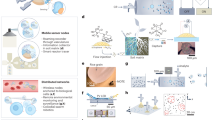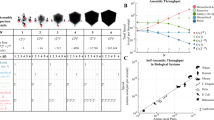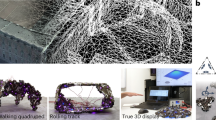Abstract
Biological organisms achieve robust high-level behaviours by combining and coordinating stochastic low-level components1,2,3. By contrast, most current robotic systems comprise either monolithic mechanisms4,5 or modular units with coordinated motions6,7. Such robots require explicit control of individual components to perform specific functions, and the failure of one component typically renders the entire robot inoperable. Here we demonstrate a robotic system whose overall behaviour can be successfully controlled by exploiting statistical mechanics phenomena. We achieve this by incorporating many loosely coupled ‘particles’, which are incapable of independent locomotion and do not possess individual identity or addressable position. In the proposed system, each particle is permitted to perform only uniform volumetric oscillations that are phase-modulated by a global signal. Despite the stochastic motion of the robot and lack of direct control of its individual components, we demonstrate physical robots composed of up to two dozen particles and simulated robots with up to 100,000 particles capable of robust locomotion, object transport and phototaxis (movement towards a light stimulus). Locomotion is maintained even when 20 per cent of the particles malfunction. These findings indicate that stochastic systems may offer an alternative approach to more complex and exacting robots via large-scale robust amorphous robotic systems that exhibit deterministic behaviour.
This is a preview of subscription content, access via your institution
Access options
Access Nature and 54 other Nature Portfolio journals
Get Nature+, our best-value online-access subscription
9,800 Yen / 30 days
cancel any time
Subscription info for Japanese customers
We have a dedicated website for our Japanese customers. Please go to natureasia.com to subscribe to this journal.
Buy this article
- Purchase on SpringerLink
- Instant access to full article PDF
Prices may be subject to local taxes which are calculated during checkout




Similar content being viewed by others
Code and data availability
The simulation code and datasets generated during this study are available at https://github.com/richa-batra/ParticleRobotSimulations.git.
References
Rørth, P. Collective guidance of collective cell migration. Trends Cell Biol. 17, 575–579 (2007).
Haeger, A., Wolf, K., Zegers, M. M. & Friedl, P. Collective cell migration: guidance principles and hierarchies. Trends Cell Biol. 25, 556–566 (2015).
Tambe, D. T. et al. Collective cell guidance by cooperative intercellular forces. Nat. Mater. 10, 469–475 (2011).
Felton, S., Tolley, M., Demaine, E., Rus, D. & Wood, R. A method for building self-folding machines. Science 345, 644–646 (2014).
Wehner, M. et al. An integrated design and fabrication strategy for entirely soft, autonomous robots. Nature 536, 451–455 (2016).
Zykov, V., Mytilinaios, E., Adams, B. & Lipson, H. Robotics: self-reproducing machines. Nature 435, 163–164 (2005).
Rubenstein, M., Cornejo, A. & Nagpal, R. Programmable self-assembly in a thousand-robot swarm. Science 345, 795–799 (2014).
Friedl, P. & Gilmour, D. Collective cell migration in morphogenesis, regeneration and cancer. Nat. Rev. Mol. Cell Biol. 10, 445–457 (2009).
Weijer, C. J. Collective cell migration in development. J. Cell Sci. 122, 3215–3223 (2009).
Méhes, E. & Vicsek, T. Collective motion of cells: from experiments to models. Integr. Biol. 6, 831–854 (2014).
Chen, J., Gauci, M., Li, W., Kolling, A. & Gross, R. Occlusion-based cooperative transport with a swarm of miniature mobile robots. IEEE Trans. Robot. 31, 307–321 (2015).
Butler, Z. & Rus, D. L. Distributed planning and control for modular robots with modules. Int. J. Rob. Res. 22, 699–715 (2000).
Gross, R., Bonani, M., Mondada, F. & Dorigo, M. Autonomous self-assembly in swarm-bots. IEEE Trans. Robot. 22, 1115–1130 (2006).
Yim, M. et al. Modular self-reconfigurable robot systems. IEEE Robot. Autom. Mag. 14, 43–52 (2007).
Rus, D. & Vona, M. Crystalline robots: self-reconfiguration with compressible unit modules. Auton. Robots 10, 107–124 (2001).
Shimizu, M., Ishiguro, A. & Kawakatsu, T. Slimebot: a modular robot that exploits emergent phenomena. In Proc. 2005 IEEE International Conference on Robotics and Automation 2982–2987 (IEEE, 2005).
Umedachi, T., Horikiri, S., Kobayashi, R. & Ishiguro, A. Enhancing adaptability of amoeboid robot by synergetically coupling two decentralized controllers inspired by true slime mold. Adapt. Behav. 23, 109–121 (2015).
Rubenstein, M., Sai, Y., Chuong, C. M. & Shen, W. M. Regenerative patterning in Swarm Robots: mutual benefits of research in robotics and stem cell biology. Int. J. Dev. Biol. 53, 869–881 (2009).
Shen, W.-M., Will, P., Galstyan, A. & Chuong, C.-M. Hormone-inspired self-organization and distributed control of robotic swarms. Auton. Robots 17, 93–105 (2004).
Camley, B. A. & Rappel, W.-J. Physical models of collective cell motility: from cell to tissue. J. Phys. D Appl. Phys. 50, 113002 (2017).
Ellison, D. et al. Cell–cell communication enhances the capacity of cell ensembles to sense shallow gradients during morphogenesis. Proc. Natl Acad. Sci. USA 113, E679–E688 (2016).
Mugler, A., Levchenko, A. & Nemenman, I. Limits to the precision of gradient sensing with spatial communication and temporal integration. Proc. Natl Acad. Sci. USA 113, E689–E695 (2016).
Zhang, L., Petit, T., Peyer, K. E. & Nelson, B. J. Targeted cargo delivery using a rotating nickel nanowire. Nanomed. Nanotechnol. 8, 1074–1080 (2012).
Sitti, M. Voyage of the microrobots. Nature 458, 1121–1122 (2009).
Hu, W., Lum, G. Z., Mastrangeli, M. & Sitti, M. Small-scale soft-bodied robot with multimodal locomotion. Nature 554, 81–85 (2018).
Butler, Z. & Rus, D. Distributed planning and control for modular robots with unit-compressible modules. Int. J. Robot. Res. 22, 699–715 (2003).
Yu, C. H., Werfel, J. & Nagpal, R. Coordinating collective locomotion in an amorphous modular robot. In Proc. IEEE Int. Conf. Robot. Autom. 2777–2784 (IEEE, 2010).
Vergara, A., Lau, Y., Mendoza-Garcia, R.-F. & Zagal, J. C. Soft modular robotic cubes: toward replicating morphogenetic movements of the embryo. PLoS One 12, e0169179 (2017).
Altemose, A. et al. Chemically controlled spatiotemporal oscillations of colloidal assemblies. Angew. Chem. Int. Ed. 56, 7817–7821 (2017).
Wang, B. et al. Reconfigurable swarms of ferromagnetic colloids for enhanced local hyperthermia. Adv. Funct. Mater. 28, 1705701 (2018).
Strogatz, S. Sync: The Emerging Science of Spontaneous Order (Hyperion, New York, 2003).
Mirollo, R. E. & Strogatz, S. H. Synchronization of pulse-coupled biological oscillators. SIAM J. Appl. Math. 50, 1645–1662 (1990).
Christensen, A. L., O’Grady, R. & Dorigo, M. From fireflies to fault-tolerant swarms of robots. IEEE Trans. Evol. Comput. 13, 754–766 (2009).
Perez-Diaz, F., Zillmer, R. & Gross, R. Firefly-inspired synchronization in swarms of mobile agents. In Proc. 2015 International Conference on Autonomous Agents and Multiagent Systems 279–286 (International Foundation for Autonomous Agents and Multiagent Systems, 2015).
Rubenstein, M., Ahler, C., Hoff, N. & Cabrera, A. Kilobot: a low cost robot with scalable operations designed for collective behaviors. Robot. Auton. Syst. 62, 966–975 (2014).
Acknowledgements
This work was supported in part by the Defense Advanced Research Projects Agency (grant number HR0011-17-2-0014) and the National Science Foundation (grant numbers 1138967 and 1830901). We also thank J. Yuan at Northwestern Polytechnical University in China for support and advice on S.L.’s work.
Reviewer information
Nature thanks Kohji Tomita and the other anonymous reviewer(s) for their contribution to the peer review of this work.
Author information
Authors and Affiliations
Contributions
H.L., S.L. and R.B. proposed the research; S.L., C.H. and H.L. designed the robots; S.L., H.L. and D.R. designed the control algorithms; S.L., D.B. and H.-D.C. fabricated the robots and conducted the physical experiments; R.B., S.L. and N.R. developed the simulations; R.B. performed the numerical experiments; R.B., S.L. and H.L. analysed the data and wrote the paper; all authors provided feedback.
Corresponding authors
Ethics declarations
Competing interests
The authors declare no competing interests.
Additional information
Publisher’s note: Springer Nature remains neutral with regard to jurisdictional claims in published maps and institutional affiliations.
Supplementary information
Supplementary Information
This file contains Supplementary Information sections S1–S9, Supplementary Figs. S1–S21, and Supplementary Tables S1–S6.
Video 1
Particle robotics overview. This video provides a summary of the paper. In it, we introduce the particle robotics concept, provide an overview of the experiments that were conducted, and illustrate the main results.
Video 2
Particle robot function. This video shows a single particle oscillating from an oblique view and then a top view. The video also demonstrates particle robot locomotion with a group of particles oscillating with position-based phase delay.
Video 3
Locomotion methodology. This video shows the locomotion experiments presented in Fig. 2. Sequentially, this includes particles with randomly assigned phase offsets initially scattered around an obstacle that begin to cluster over time; particles with randomly assigned phase offsets that are placed in a grid with an object intended for transport located in the centre, and move in an unpredictable direction; three particles in a row with sequentially assigned phase offsets exhibiting forward locomotion; three particles in an asymmetric configuration which produce turning with a consistent radius of curvature; a grid of particles that exhibit forward locomotion when assigned a phase offset relative to their respective distances from the top centre particle; a grid of cells containing a column of inactive particles in the middle with the other particles assigned a mirrored phase offset pattern about the column, resulting in turning; a grid of particles with the phase offset defined asymmetrically producing translation and rotation.
Video 4
Phototaxis experiments and demonstrations. This video shows the experimental procedure for particle robot phototaxis, including the phase reset period when the overhead lights are turned off; this is generally removed from the videos to reduce the video length and file size. This video also shows the behaviours demonstrated with phototaxis, specifically locomotion towards changing light sources, cooperative object transport, and obstacle avoidance; these experiments correspond to Fig. 3a–c.
Video 5
Simulation parameter fitting and validation. This video shows the phototaxis experiment (five particles in a row) which was used for fitting the simulation spring and damping parameters; it is shown alongside the simulation of the experiment, and then transparently overlapping with the simulation. The video also shows the phototaxis experiment (amorphous configuration of ten particles) used to validate the parameters, along with the corresponding simulation (side by side and overlapped)
Video 6
Particle robotics simulation studies. This video shows examples of the dead particle, object transport, and narrow gap simulation studies. First, particle robots comprising 10, 100, 1,000, and 10,000 particles are shown with 0%, 20%, 40%, and 60% dead particles, sequentially. Similarly, particle robots with 10,000, 1,000, 100, and 10 particles are shown with a circular object in front of their path that is intended for transport. The radius of the object varies from 20%, 40%, 60%, and 80% of the densest packing diameter, which is an approximate measure of the particle robot size. The mass of the object is equivalent to that of one particle and the coefficient of friction is also the same; the only parameter that is varied is the size of the object. Lastly, particle robots comprising 10,000, 1,000, 100, and 10 particles are shown moving through a narrow gap. The width of the gap varies from 20%, 40%, 60%, and 80% of the densest packing diameter. The simulations are shown at a speed that is 1,000 times that of the physical robot
Rights and permissions
About this article
Cite this article
Li, S., Batra, R., Brown, D. et al. Particle robotics based on statistical mechanics of loosely coupled components. Nature 567, 361–365 (2019). https://doi.org/10.1038/s41586-019-1022-9
Received:
Accepted:
Published:
Issue Date:
DOI: https://doi.org/10.1038/s41586-019-1022-9
This article is cited by
-
Targets capture by distributed active swarms via bio-inspired reinforcement learning
Science China Physics, Mechanics & Astronomy (2025)
-
Autonomous mining through cooperative driving and operations enabled by parallel intelligence
Communications Engineering (2024)
-
Snail-inspired robotic swarms: a hybrid connector drives collective adaptation in unstructured outdoor environments
Nature Communications (2024)
-
Electrically activated ferroelectric nematic microrobots
Nature Communications (2024)
-
Robots that evolve on demand
Nature Reviews Materials (2024)



